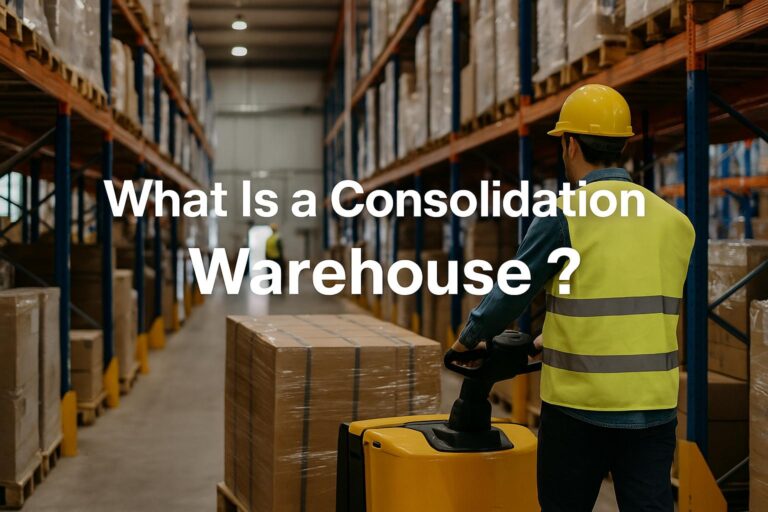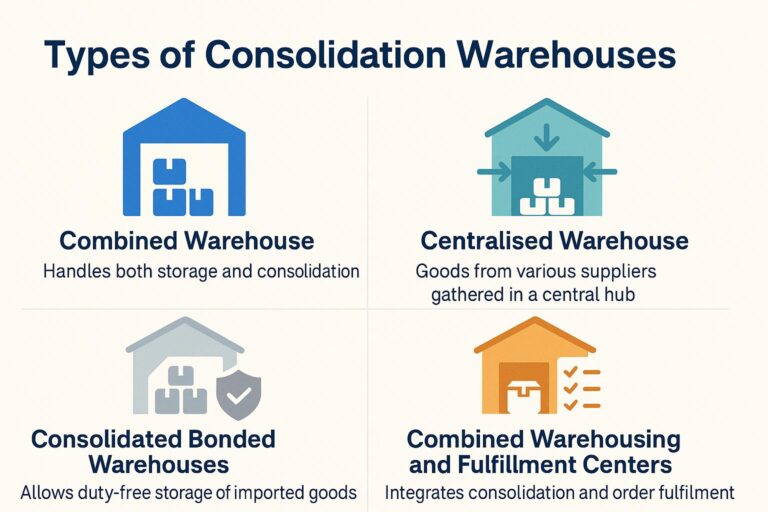Warehouse
ONE-STOP GLOBAL LOGISTICS PROVIDER
Warehouse & Cargo Consolidation
China warehousing & consolidation services play a vital role in helping businesses reduce shipping costs, streamline warehouse operations, and improve overall delivery performance. In today’s global logistics landscape, companies increasingly rely on professional consolidation services to combine shipments from multiple suppliers into a single load, reducing transportation expenses, saving time, and improving supply chain efficiency.
Tonlexing is a leading provider of warehousing and consolidation services in China, operating 10 facilities across Qingdao, Tianjin, Ningbo, Shanghai, Guangzhou, Shenzhen, and Hong Kong. With over 95,000 sqm of warehouse space, we offer:
Reliable storage and handling
Efficient cargo consolidation for cost-effective shipping
With Tonlexing’s extensive network and professional support, your shipments are always in good hands.

Table of Contents
- 1. What Is a Consolidation Warehouse?
- 2. How Does a Consolidation Warehouse Work?
- 3. Types of Consolidation Warehouses
- 4. Benefits of Warehouse Consolidation for Global Shipping
- 5. Consolidated Shipments: Definition and Process
- 6. Warehouse Consolidation in China: A Strategic Logistics Choice
- 7. When Should You Use a Consolidation Warehouse?
- 8. Choosing a Reliable Partner for Cargo Consolidation
- 9. FAQ: Common Questions About Consolidated Warehouses
- 10.Conclusion: Boost Efficiency with Smart Warehouse Consolidation
What Is a Consolidation Warehouse?
A consolidation warehouse is a specialized storage facility designed to receive cargo from multiple suppliers, combine loads, and ship them as one consolidated shipment to the final destination. This logistics model is especially useful for businesses sourcing products from different suppliers who are located in the same region or same location.
Unlike traditional warehousing, where goods are stored for long periods, a consolidation warehouse operates as a temporary hub within the distribution process, where incoming small shipments are grouped into larger shipments based on factors like delivery route, destination, or product type.
Consolidated Warehouse Meaning
The term “consolidated warehouse” refers to a facility that handles the consolidation process, which involves sorting, scanning, and combining goods into fewer shipments. This approach helps reduce costs, lower transportation costs, and improve supply chain efficiency by minimizing freight charges and maximizing truckload utilization.
Cargo Consolidation vs Traditional Shipping
With cargo consolidation, rather than sending multiple shipments individually, companies benefit from sending a single shipment, often with volume discounts and lower fuel consumption. This not only reduces transportation costs, but also simplifies inventory management and tracking for logistics managers.
Using a consolidation warehouse is essential in international shipping, especially when dealing with multiple small orders destined for the same direction or end customer. It’s a smart move for improving overall efficiency, optimizing available space, and increasing customer satisfaction.

How Does a Consolidation Warehouse Work?
The consolidation process begins when individual shipments from different suppliers are received by a consolidation warehouse. These shipments are temporarily stored, sorted, and processed according to their destination, product type, and shipping requirements.
At its core, this process involves:
Inventory consolidation – All inbound cargo is registered and merged into a unified inventory system.
Load consolidation – Smaller parcels or pallets are grouped into larger, more efficient unit loads.
Labeling and documentation – Products are relabeled under a single shipment reference to simplify tracking and customs clearance.
Final dispatch – Once fully prepared, the consolidated shipment is loaded and dispatched toward the final destination as a full truckload (FTL), less-than-truckload (LTL), or in containerized form.
The Role of a Consolidation Center
A consolidation center plays a critical role in this workflow. These specialized facilities are equipped with modern warehouse operations systems, including automated storage, barcode tracking, and real-time inventory updates. By managing the consolidation processes efficiently, these centers ensure seamless cargo flow, accurate inventory control, and on-time delivery.
Why Load Consolidation Matters
Instead of sending multiple shipments separately, load consolidation allows businesses to send goods using fewer vehicles or containers. This not only reduces transport costs, but also supports fewer emissions, better supply chain agility, and lower operational costs.
With optimized warehouse operations, proper layout, and system integration, consolidation warehouses help companies deal with increasing e-commerce demand, tight delivery windows, and cross-border logistics with ease.

Types of Consolidation Warehouses
There are various types of consolidation warehouses, each serving a specific function within the supply chain. Choosing the right type depends on your cargo volume, shipping frequency, and international requirements. Below are the most common models:
Combined Warehouse
A combined warehouse is designed to handle both storage and consolidation tasks. These facilities allow for short-term storage while simultaneously preparing cargo for load consolidation. This model is especially useful for businesses managing multiple shipments across multiple locations, offering flexible stock storage and staging solutions.
Centralised Warehouse
A centralised warehouse serves as a hub in the distribution network, where goods from various suppliers are gathered in a single facility. This setup enhances supply chain efficiency by reducing duplication of routes, improving transport coordination, and ensuring smoother outbound flow of consolidated shipments.
By consolidating inventory in a centralised location, companies can better monitor stock levels, streamline the distribution process, and reduce transportation costs significantly—especially for regional and international shipping.
Consolidated Bonded Warehouses
are customs-approved facilities that allow for duty-free storage and cargo consolidation of imported goods. These storage facilities are ideal for importers who want to delay tax payments until the goods are officially released into the market or reshipped to another country.
Bonded warehousing is especially advantageous when consolidating goods for cross-border delivery or international bulk shipments, as it offers a secure and cost-effective logistics solution with customs compliance.
Combined Warehousing and Fulfillment Centers
In some cases, businesses may opt for combined warehousing solutions, which integrate consolidation functions with eCommerce fulfillment. This hybrid model supports automated storage, inventory management, order consolidation, and final packaging—reducing operational steps and improving customer satisfaction.

Benefits of Warehouse Consolidation for Global Shipping
Implementing warehouse consolidation offers significant advantages for companies involved in domestic and international shipping. Whether you’re dealing with frequent small shipments or managing a growing number of customer orders, consolidation can bring measurable benefits to your entire supply chain.
Reduced Transportation Costs
By consolidating shipments from multiple suppliers into a single shipment, businesses can minimize the number of trucks or containers needed for delivery. This leads to:
Lower transportation costs
Reduced fuel consumption
Fewer shipments, which reduces tolls, labor, and vehicle usage
Consolidation also helps companies optimise transportation, especially when sending goods in the same direction to the same location or final destination.
Lower Shipping Costs
Through freight consolidation, businesses can take advantage of volume discounts from carriers and benefit from reduced shipping costs. Sending full loads instead of fragmented ones helps minimize freight charges and avoid unnecessary handling fees.
Improved Supply Chain Logistics
Centralizing your distribution in a consolidation warehouse improves supply chain logistics and overall efficiency. It streamlines logistics operations, enhances coordination between suppliers, and reduces bottlenecks in warehouse operations.
With better planning, businesses can align shipping schedules, coordinate delivery times, and maintain higher inventory visibility, all of which contribute to a more agile and cost-effective supply chain.
Enhanced Customer Satisfaction
By reducing lead times and improving delivery accuracy, consolidation helps increase customer satisfaction. Goods arrive on time, in one shipment, and with fewer discrepancies. This reliability is especially important for retailers, eCommerce businesses, and distributors serving time-sensitive markets.
Environmentally Friendly Shipping
Fewer trucks on the road mean fewer emissions. For businesses aiming to reduce their environmental footprint, consolidation is a practical step toward sustainable logistics.
Consolidated Shipments: Definition and Process
A consolidated shipment refers to the logistics practice of combining loads from multiple sources into one single shipment that is delivered together to the end customer or regional hub. This method is widely used in international shipping to cut costs, simplify customs procedures, and reduce delays.
Consolidated Shipment Meaning
In simple terms, consolidated shipping involves grouping cargo from different suppliers into a single container or truckload, rather than sending each shipment separately. This is especially effective when products are destined for the same location or final destination.
The Process of Consolidating Shipments
Here’s how consolidating shipments typically works:
Cargo arrival: Multiple shipments arrive at the consolidation warehouse from different suppliers.
Order consolidation: Shipments are matched, labeled, and combined based on destination, customer order, or delivery route.
Load building: Goods are packed into shared containers or trucks to create a single shipment.
Dispatch and tracking: The consolidated load is shipped with complete documentation, offering full tracking to the end customer.
Advantages of Consolidated Shipping
Saves money by reducing freight charges
Speeds up delivery through streamlined logistics
Reduces the number of multiple small shipments
Improves handling efficiency and operational flow
This shipping model is ideal for small- to mid-sized businesses that import lower-volume goods from multiple suppliers but want the benefits of full-container load pricing and fewer shipments to manage.
As global logistics becomes more complex, consolidated shipping is becoming an essential tool for efficient, cost-effective distribution.

Warehouse Consolidation in China: A Strategic Logistics Choice
China remains the world’s leading manufacturing hub, and efficient warehouse consolidation services in China are now crucial for international buyers aiming to streamline their supply chain logistics. By utilizing a consolidation warehouse in China, importers can gather goods from multiple suppliers across regions like Guangdong, Zhejiang, and Jiangsu, then ship them out together in one single shipment.
Why Use a Warehouse from China?
Using a warehouse from China as your consolidation facility offers several strategic advantages:
Proximity to suppliers: China’s industrial clusters make it easy to coordinate pickups from different factories within a short timeframe.
Wide shipping options: Whether by sea, air, or rail, China offers flexible shipping options to meet both budget and delivery time requirements.
Optimized storage space: Advanced warehousing China operations are equipped with smart layouts and automated storage systems to maximize available space.
Consolidation Centers in Major Chinese Cities
Key cities like Shenzhen, Guangzhou, Yiwu, Ningbo, and Shanghai host world-class consolidation centers. These facilities receive goods, handle quality checks, merge shipments, and prepare export documentation — all under one roof.
For eCommerce sellers, Amazon FBA importers, and trading companies, consolidation warehouses in China enable smoother workflows, cost reduction, and better management of customer orders from different suppliers.
By working with a reliable logistics partner in China who understands local regulations, customs clearance processes, and transportation networks, businesses can ensure faster turnaround and improve customer satisfaction on a global scale.
When Should You Use a Consolidation Warehouse?
Warehouse consolidation isn’t just for large-scale operations—it’s an adaptable logistics strategy that benefits companies of all sizes. Knowing when to use a consolidation warehouse can greatly improve your logistics operations, reduce overhead, and optimize your supply chain.
You Should Consider Using Consolidation Warehousing When:
You source products from multiple suppliers: Instead of managing multiple shipments and dealing with inconsistent delivery times, you can combine loads at a central warehouse before shipping.
You want to reduce transport costs: Shipping smaller orders separately results in high transport costs. A consolidated shipment sent via the same truck or container to a final destination can cut freight expenses significantly.
You need to manage limited storage space: If your destination warehouse has limited storage facilities, sending consolidated goods in bulk minimizes the frequency of incoming shipments and improves inventory control.
You operate across multiple locations: Consolidation helps streamline operations by shipping consolidated cargo to regional hubs or directly to end customers.
You are shipping international orders: For global logistics, unit loads built from consolidated shipments simplify customs clearance and documentation.
You handle small or irregular orders: Rather than shipping partial loads, it’s more efficient to accumulate orders over time and send them together—resulting in fewer trips and better warehouse operations flow.
By strategically integrating consolidation into your distribution process, your business can take advantage of fewer shipments, better planning, and a more agile supply chain.

Choosing a Reliable Partner for Cargo Consolidation
A successful freight consolidation strategy depends on choosing the right logistics partner—one that not only understands the technical aspects of warehouse operations, but also has the infrastructure and expertise to ensure on-time delivery, accurate documentation, and smooth customs clearance.
Why the Right Freight Forwarder Matters
A professional freight forwarder coordinates the entire consolidation process: from receiving goods from multiple suppliers, to overseeing inventory consolidation, creating efficient unit loads, and arranging the final dispatch to the end customer.
With proper system integration, they help unify communication across different parties—factories, warehousing teams, and transportation providers—ensuring a successful implementation of your supply chain strategy.
What to Look For in a Consolidation Partner:
Experienced logistics managers who understand both Chinese and international shipping protocols.
Access to modern consolidation warehouses and consolidation centers located near key ports or industrial zones.
Ability to integrate systems for real-time tracking, inventory management, and automated labeling.
Transparent pricing that includes clear breakdowns of freight charges, storage space, and handling.
A strong record of improving customer satisfaction through timely delivery and reduced shipping errors.
The right logistics provider will not only help you reduce costs, but also improve supply chain visibility, reduce risks, and adapt quickly to market demands—giving you a competitive edge in your industry.
FAQ: Common Questions About Consolidated Warehouses
What is a consolidated warehouse?
A consolidated warehouse is a logistics facility where cargo from multiple suppliers is gathered, sorted, and packed into one consolidated shipment for more efficient delivery. It plays a vital role in reducing shipping costs and optimizing supply chain logistics.
What is the meaning of consolidated shipment?
A consolidated shipment means combining smaller shipments from various sources into one larger load. This approach helps reduce transport costs, saves on freight charges, and improves delivery efficiency.
How is a consolidation warehouse different from a traditional warehouse?
While a traditional warehouse focuses on long-term storage space, a consolidation warehouse operates as a short-term distribution center. Its primary function is to combine loads and dispatch them together, especially when dealing with multiple shipments heading to the same destination.
Is warehouse consolidation suitable for small businesses?
Yes. In fact, cargo consolidation is highly beneficial for small and medium-sized businesses that deal with multiple small shipments. It allows them to access lower shipping rates without the need to order in bulk from a single supplier.
Does warehouse consolidation help reduce fuel consumption?
Yes. By combining shipments into fewer trips, businesses can significantly cut down on fuel consumption, leading to lower environmental impact and transportation costs.
Where are the best consolidation warehouses located in China?
Top locations include Shenzhen, Guangzhou, Yiwu, Ningbo, and Shanghai. These regions have well-developed logistics hubs, modern storage facilities, and excellent connections for international shipping.
What is the main benefit of using a consolidation center?
The main benefit is cost efficiency. A consolidation center allows you to ship smarter by reducing the number of shipments, lowering freight charges, and optimizing delivery times—all while improving customer satisfaction.
Conclusion: Boost Efficiency with Smart Warehouse Consolidation
Why Warehouse Consolidation Matters
In today’s fast-paced and cost-sensitive logistics environment, warehouse consolidation has become a strategic tool for companies aiming to streamline their supply chain logistics, reduce shipping costs, and improve service to the end customer.
The Power of Combining Loads
By using a consolidation warehouse, businesses can:
Combine shipments from multiple suppliers
Cut transportation costs
Reduce handling time
Optimize storage space
Maximize delivery efficiency
Whether you’re a small importer or a global brand, freight consolidation helps you move smarter and save more.
Enhancing Efficiency with DDP and Door-to-Door Services
Many businesses now combine consolidation with:
DDP (Delivered Duty Paid) shipping
Door-to-door delivery solutions
This allows you to outsource the entire process—from cargo collection to customs clearance, tax handling, and final delivery—with minimal hassle.
Choosing the Right Freight Forwarder
To fully benefit from warehouse consolidation, it’s crucial to work with an experienced logistics partner.
A reliable freight forwarder will manage:
Supplier coordination
Consolidation processes
Export compliance
On-time door-to-door delivery under DDP terms
Get Started with Tonlexing
Ready to reduce logistics costs and simplify your supply chain?
Contact our consolidation team today to explore flexible warehousing, DDP, and door-to-door shipping solutions from China—designed to fit your business.


